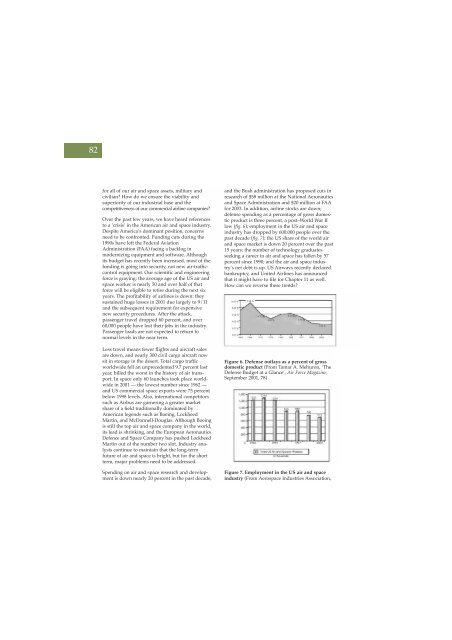Volume 6 No 4 - Royal Air Force Centre for Air Power Studies
Volume 6 No 4 - Royal Air Force Centre for Air Power Studies
Volume 6 No 4 - Royal Air Force Centre for Air Power Studies
You also want an ePaper? Increase the reach of your titles
YUMPU automatically turns print PDFs into web optimized ePapers that Google loves.
82<br />
<strong>for</strong> all of our air and space assets, military and<br />
civilian? How do we ensure the viability and<br />
superiority of our industrial base and the<br />
competitiveness of our commercial airline companies?<br />
Over the past few years, we have heard references<br />
to a ‘crisis’ in the American air and space industry.<br />
Despite America’s dominant position, concerns<br />
need to be confronted. Funding cuts during the<br />
1990s have left the Federal Aviation<br />
Administration (FAA) facing a backlog in<br />
modernizing equipment and software. Although<br />
its budget has recently been increased, most of the<br />
funding is going into security, not new air-trafficcontrol<br />
equipment. Our scientific and engineering<br />
<strong>for</strong>ce is graying: the average age of the US air and<br />
space worker is nearly 50 and over half of that<br />
<strong>for</strong>ce will be eligible to retire during the next six<br />
years. The profitability of airlines is down: they<br />
sustained huge losses in 2001 due largely to 9/11<br />
and the subsequent requirement <strong>for</strong> expensive<br />
new security procedures. After the attack,<br />
passenger travel dropped 60 percent, and over<br />
60,000 people have lost their jobs in the industry.<br />
Passenger loads are not expected to return to<br />
normal levels in the near term.<br />
Less travel means fewer flights and aircraft sales<br />
are down, and nearly 300 civil cargo aircraft now<br />
sit in storage in the desert. Total cargo traffic<br />
worldwide fell an unprecedented 9.7 percent last<br />
year, billed the worst in the history of air transport.<br />
In space only 60 launches took place worldwide<br />
in 2001 — the lowest number since 1962 —<br />
and US commercial space exports were 75 percent<br />
below 1998 levels. Also, international competitors<br />
such as <strong>Air</strong>bus are garnering a greater market<br />
share of a field traditionally dominated by<br />
American legends such as Boeing, Lockheed<br />
Martin, and McDonnell-Douglas. Although Boeing<br />
is still the top air and space company in the world,<br />
its lead is shrinking, and the European Aeronautics<br />
Defence and Space Company has pushed Lockheed<br />
Martin out of the number two slot. Industry analysts<br />
continue to maintain that the long-term<br />
future of air and space is bright, but <strong>for</strong> the short<br />
term, major problems need to be addressed.<br />
Spending on air and space research and development<br />
is down nearly 20 percent in the past decade,<br />
and the Bush administration has proposed cuts in<br />
research of $58 million at the National Aeronautics<br />
and Space Administration and $20 million at FAA<br />
<strong>for</strong> 2003. In addition, airline stocks are down;<br />
defense spending as a percentage of gross domestic<br />
product is three percent, a post–World War II<br />
low (fig. 6); employment in the US air and space<br />
industry has dropped by 600,000 people over the<br />
past decade (fig. 7); the US share of the world air<br />
and space market is down 20 percent over the past<br />
15 years; the number of technology graduates<br />
seeking a career in air and space has fallen by 57<br />
percent since 1990; and the air and space industry’s<br />
net debt is up. US <strong>Air</strong>ways recently declared<br />
bankruptcy, and United <strong>Air</strong>lines has announced<br />
that it might have to file <strong>for</strong> Chapter 11 as well.<br />
How can we reverse these trends?<br />
Figure 6. Defense outlays as a percent of gross<br />
domestic product (From Tamar A. Mehuron, ‘The<br />
Defense Budget at a Glance’, <strong>Air</strong> <strong>Force</strong> Magazine,<br />
September 2001, 78)<br />
Figure 7. Employment in the US air and space<br />
industry (From Aerospace Industries Association,
















